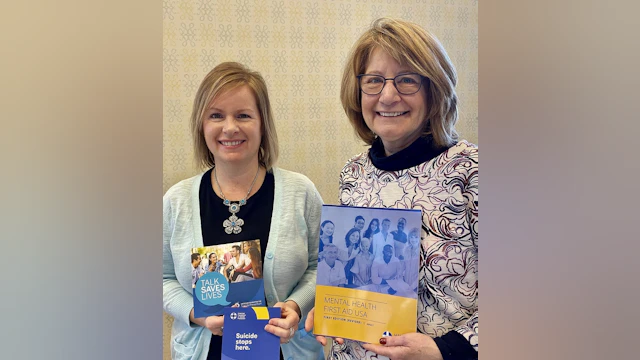Mar. 3, 2020 - Butterflies swirled in my stomach as I made my way through security at a jail in Springfield, Massachusetts. As a trainer and co-chair of the board of the Massachusetts chapter of the American Foundation for Suicide Prevention (AFSP), this was my first time meeting adults in custody and delivering suicide prevention education to both them and staff. My co-trainer and I had agreed to present to about 20 women in custody. Suicide is the leading cause of death in jails, according to the U.S. Department of Justice. I felt the importance of this training both intellectually and in my heart.
I wasn’t sure what to expect in this environment. Luckily, my co-trainer, Denise Kindschi Gosselin, is a retired state trooper who had trained adults in custody before, and knew the facility well. I left the training on an excited and proud high, feeling we had really made a difference in the lives of these fellow women.
AFSP is targeting the corrections system as one of four key areas of focus as part of Project 2025 – a collaborative, nationwide effort to reduce the suicide rate 20% by 2025. It has been determined – with guidance from the top minds in the suicide prevention field, and through dynamic data modeling – that with help from key partners, we will be able to save the most lives in the shortest amount of time by focusing on the following critical areas: corrections; emergency rooms; healthcare; and firearms. AFSP is currently developing a Corrections module of our Talk Saves Lives educational program, due to launch in the spring of 2020. In the meantime, AFSP offers evidence-based programs, both its own and some developed by outside firms. Denise and I chose to use Mental Health First Aid training for this instance, primarily because it is a certification course that adults in custody would be able to put on their resumes, which we felt would be especially valuable to them.
People in custody are particularly vulnerable to suicide, and research shows that times of transition are especially high-risk. The Western Mass Recovery and Wellness Center is a minimum security, pre-release facility, which means the adults in custody will reenter society after completing their time and treatment there. Many, if not all, are there for substance use. Many have experienced trauma(s).
There are a variety of unique considerations for training in a corrections environment. We taught the class in a conference room, in two four-hour sessions on consecutive Fridays, to accommodate the jail’s scheduling needs. To help me prepare, I spoke with Alex Karydi, AFSP’s Project 2025 Director, who has experience teaching in correctional settings. She stressed the importance of communicating directly with managerial staff ahead of time to discuss the protocol the facility has in place to provide mental healthcare to adults in custody who may be struggling. We discussed my comfort level, safety, and strategies for optimal communication.
Denise and I established from the get-go that active participation was required, and I was delighted that the 12 adults in custody (most of whom appeared in their 20s and early 30s), as well as their counselor and “unit director,” more than met this challenge. Perhaps it helped that we brought coffee and donuts and muffins! Trust was mutually built as we spent more time together and shared some personal stories. Many adults in custody talked about their family members or friends living with mental illness, or their own struggles and experiences with it. One had lost a child to suicide, and then became involved with a suicide prevention organization as part of her healing. Her story is similar to mine, in that I lost my beloved mom to suicide and also took up the cause as a result.
I was initially concerned that having staff present might interfere with the participants’ willingness to be open and vulnerable in our discussions. But this was not the case at all. The staff in attendance appeared to have a genuinely wonderful rapport with the adults in custody; having them train alongside each other seemed a unique and special experience for all involved.
At one of the breaks, we invited everyone to take AFSP literature that included information on what to do in a crisis, surviving suicide loss, information for after an attempt, and more.
At the end of the training, Denise and I were very pleased to be presented with flowers and cards signed by the participants. One of the participants who had been discharged from the facility after our first session even returned just to complete the course! She remarked that the course helped her better understand her father's mental illness, which had taken a major toll on her as a child, and is something she continues to deal with now as an adult. Another woman said, “I’ve gained so much knowledge." Another described the training as “a tool for survival.”
Many of the participants’ notes expressed deep gratitude for our having “taken the time” for them, which I believe speaks to the isolation, possible feelings of being a burden, and/or or not belonging many of the adults in custody may experience, all of which are risk factors for suicide. This is a testament to why suicide prevention and mental health trainings are so important for these facilities.
We concluded the training with a “graduation ceremony," handing each participant a certificate and AFSP wristband. We also gave the jail’s clinical manager a Suicide Prevention Resource Guide that AFSP has developed with the National Commission on Correctional Health Care, which she shared with the facility’s Suicide Prevention Committee.
The day was just as meaningful to me as it seemed to be for all the people involved. I’m in the process, with my local AFSP chapter, of coordinating more trainings for correctional facilities, and feel honored to have the opportunity to try and make a difference in the lives of people who are incarcerated.
To learn more about Project 2025, click here.
